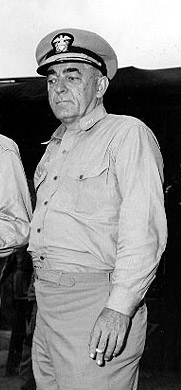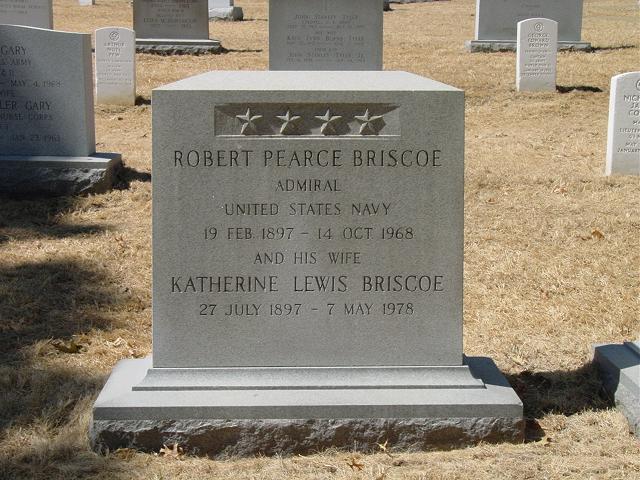Robert Pearce Briscoe (February 19, 1897 — October 14, 1968) was an Admiral of the United States Navy. He commanded two ships, a destroyer squadron, and an amphibious group during World War II. He later served as Commander-in-Chief, Allied Forces, Southern Europe, from 1956 to 1959. He was a native of Centreville, Mississippi.
Admiral Briscoe graduated from the United States Naval Academy in June 1918. During World War I he served on the battleship USS Alabama (BB-8) of the U.S. Atlantic Fleet and on the destroyer USS Roe (DD-24), operating from Brest, France. At the end of hostilities, he made the first postwar Midshipmen cruise in the USS Kearsarge (BB-5) and in 1919 returned to destroyer duty as Engineer Officer of the USS Humphreys (DD-236), stationed in Near East waters at Constantinople. During the Turko-Greek fighting in 1920-1921, he commanded a naval landing force at Derindge, Turkey.
After further destroyer duty in the USS Flusser (DD-289) and USS Henderson (AP-1), and recruiting duty at Little Rock, Arkansas, he served as Senior Assistant Engineer of the battleship USS West Virginia (BB-48) from 1926 to 1929, then returned to the Naval Academy as an instructor in Mechanical Engineering. From 1931 to 1933 he was on China Station, assigned first as Executive Officer of the USS Edsall (DD-219), on Yangtze River patrol during the Japanese occupation of Woosung and Manchuria, and later as Communication Officer of the USS Houston (CA-30), flagship of the Commander in Chief, Asiatic Fleet. He again returned to the Naval Academy in June 1934, and for three years served as head of the Department of Chemistry.
Sea duty as navigator of the battleship USS Mississippi (BB-41) preceded a tour during the prewar period as Assistant Director of the U.S. Naval Research Laboratory and Navy Department Liaison Officer with the National Defense Research Committee. He has been identified as one of the pioneers of modern electronics development in the Navy.
In May 1942 he assumed command of the USS Prometheus (AR-3), a recommissioned World War I repair ship. Under his command she joined the U.S. 3rd Fleet at Noumea, New Caledonia, where he was detached to command Destroyer Squadron 5 and operated as escort commander for Task Forces 67, 68 and 70. In the intervening periods when the battleships and cruisers were not at sea, Admiral Briscoe operated Commander Task Group 675 (Cactus Striking Force) in Guadalcanal waters.
He was transferred to command of the USS Denver (CL-58) in July 1943 and was in command during the Northern Solomon Islands campaign. During a thirty six hour battle with Japanese naval forces his ship assisted in the sinking of five enemy warships, damaging four others and routing the enemy’s surface forces. His ship’s guns had barely fired their last salvo when she was attacked by sixty-seven dive bombers. Under his command, the ship downed seventeen enemy planes and thwarted the raid. He sailed the cruiser to the United States after she suffered severe battle damage off Rabaul in November 1943.
In February 1944 he joined the staff of the Commander in Chief, U.S. Fleet, in Washington, D.C., as head of New Developments, and with his promotion to flag rank in April 1945, assumed command of Amphibious Group 14. Victory over Japan Day found him in Manila, working on plans for the invasion of the Japanese homeland.
In September 1945 he took command of the Operational Development Force, Atlantic Fleet with headquarters at Norfolk, Virginia. After two years there, and a tour of duty as Assistant Chief of Naval Operations (Readiness), he became Commander Amphibious Force, Atlantic Fleet, on November 1, 1950.
Ordered in January 1952 to command the U.S. 7th Fleet in Korean waters, he retained this command until designated Commander Naval Forces, Far East, in June of that year. During this tenure, he recommend an amphibious feint to draw North Korean combatants from their dug in front line positions to cover potential landing zones. This resulted in a significant shift of troop concentrations by enemy forces over a period of three months.
Two years later he reported as Deputy Chief of Naval Operations, for Fleet Operations and Readiness, and on 2 July 1956, became Commander in Chief, Allied Forces, Southern Europe.
Decorations and awards:
Legion of Merit with Gold Star
Navy Cross for actions in the Northern Solomon Islands campaign.
Distinguished Service Medal in his capacity as CinC of Allied Forces, Southern Europe from July 2, 1956 to December 31, 1958.
On 1 January 1959 he was transferred to the Retired List of the U.S. Navy. He died on 14 October 1968 in Liberty, Mississippi. He was buried with full military honors in Arlington National Cemetery.
USS Briscoe (DD-977), a Spruance class destroyer was named in his honor.
A native of Centerville, Mississippi, Admiral Briscoe was graduated from the Naval Academy in June 1918. During World War I he served in the battleship ALABAMA of the Atlantic Fleet and in the destroyer ROE, operating from Brest, France. At the end of hostilities, he made the first postwar Midshipmen cruise in the USS KEARSARGE and in 1919 returned to destroyer duty as Engineer Officer of the USS HUMPHREYS, stationed in Near East waters at Constantinople. During the Turko-Greek fighting in 1920-1921, he commanded a Naval landing force at Derindge, Turkey.
After further destroyer duty in the USS FLUSSER and USS HENDERSON, and recruiting duty at Little Rock, Arkansas, he served as Senior Assistant Engineer of the battleship WEST VIRGINIA (1926-1929), then returned to the Naval Academy as an instructor in Mechanical Engineering. In 1931-1933 he was on China Station, assigned first as Executive Officer of the USS EDSALL, on Yangtze Patrol during the Japanese occupation of Woosung and Manchuria, and later as Communication Officer of the USS HOUSTON, flagship of the Commander in Chief, Asiatic Fleet. He again returned to the Naval Academy in June 1934, and for three years served as Head of the Department of Chemistry.
Sea duty as Navigator of the battleship MISSISSIPPI preceded a tour during the prewar period as Assistant Director of the U.S. Naval Research Laboratory and Navy Department Liaison Officer with the National Defense Research Committee. He has been identified as one of the pioneers of modern electronics development in the Navy. In May 1942 he assumed command of the USS PROMETHEUS, a recommissioned World War I repair ship. Under his command she joined the THIRD Fleet at Noumea, Caledonia, where he was detached to command Destroyer Squadron 5 and operated as escort commander for Task Forces 67, 68 and 70. In the intervening periods when the battleships and cruisers were not at sea, Admiral Briscoe operated Commander Task Group 675 (Cactus Striking Force) in Guadalcanal waters. He was transferred to command of the USS DENVER in July 1943, and returned that cruiser to the United States after she suffered severe battle damage off Rabaul in November 1943.
In February 1944 he joined the Staff of the Commander in Chief, U.S. Fleet, in Washington, as Head of New Developments, and with his promotion to flag rank in April 1945, assumed command of Amphibious Group 14. V-J Day found him in Manila, working on plans for the invasion of the Japanese homeland. In September 1945 he took command of the Operational Development Force, Atlantic Fleet with headquarters at Norfolk, Virginia. After two years there, and a tour of duty as Assistant Chief of Naval Operations (Readiness), he became Commander Amphibious Force, Atlantic Fleet, on November 1, 1950.
Ordered in January 1952 to command the SEVENTH Fleet in Korean waters, he retained this command until designated Commander Naval Forces, Far East, in June of that year. Two years later he reported as Deputy Chief of Naval Operations, for Fleet Operations and Readiness, and on July 2, 1956, became Commander in Chief, Allied Forces, Southern Europe. “For exceptional meritorious service … (in that capacity) from July 2, 1956 to December 31, 1958. .. ” he was awarded the Distinguished Service Medal. On January 1, 1959 he was transferred to the Retired List of the U.S. Navy. He died on October 14, 1968 in Liberty, Mississippi.
Briscoe, Robert Pearce
Robert Pearce Briscoe was born at Centerville, Mississippi, February 19, 1897. He graduated from the United States Naval Academy in, 1918. He was a student at Marion Institute, 1914-15. He married Katherine Norwood Lewis, August 22, 1923.
Admiral Briscoe was commissioned as Ensign in 1918 and advanced through grades to Armiral in 1956.
He served in destroyer convoy escort duty, Europe, World War I.
He then served in the Near-East, 1919-21. Assistant Engineering Officer, USS West Virginia, 1926-29. Instructor, USNA, 1929-31, 1934-37. China duty, 1931-33. Navigation officer, USS Mississippi, 1937-39. Assistant Director Naval Research Laboratory, 1939-41. Commander, USS Prometheus, Destroyer Squadron 5, USS Denver, Amphibious Group 14, 1942-44.
He was on the staff of the Commander-in-Chief, US Fleet, 1944. Commander, Operational Development Force, 1945-48. Commander, Amphibious Force, Atlantic Fleet, 1950. Commander, 7th Fleet, Korea, 1952. Commander, USN Forces, Far East, 1952-54. Deputy Chief of Naval Operations, 1954-56. Commander-in-Chief, Allied Forces, Southern Europe, 1956-59, with rank of Admiral.
His medals include the Navy Cross, Distinguished Service Medal, the Legion of Merit with Gold Star, a commendation ribbon, a citation from Secretary of the Navy. Presbyterian. Home: Liberty, Mississippi.
Admiral Briscoe died on October 14, 1968 and was buried with full military honors in Arlington National Cemetery.
BRISCOE, ROBERT PEARCE
- ADM, USN
- DATE OF BIRTH: 02/19/1897
- DATE OF DEATH: 10/14/1968
- BURIED AT: SECTION 2 SITE 3387-C
- ARLINGTON NATIONAL CEMETERY
Michael Robert Patterson was born in Arlington and is the son of a former officer of the US Army. So it was no wonder that sooner or later his interests drew him to American history and especially to American military history. Many of his articles can be found on renowned portals like the New York Times, Washingtonpost or Wikipedia.
Reviewed by: Michael Howard


